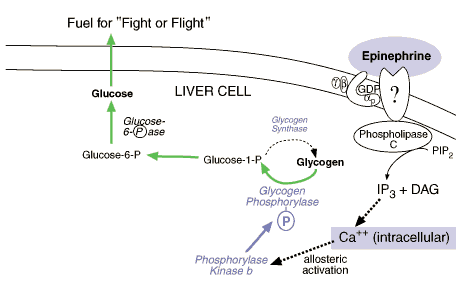|
Think of this as an auxiliary action of epinephrine to
boost the action of glycogen phosphorylase in a true emergency.
Recall that phosphorylase kinase is the enzyme that phosphorylates
and activates glycogen phosphorylase, and that phosphorylase kinase
b, the inactive form, can be phosphorylated to phosphorylase kinase
"a" (active) as part of a phosphorylation cascade initiated by cAMP
and protein kinase A.
A part of the regulation you may have forgotten
is that intracellular calcium can activate phosphorylase kinase b
even in the absence of the phosphorylation signal. This effect would
then activate even those molecules of phosphorylase kinase that did
not become phosphorylated in the cascade, creating an additive effect
to boost glycogen hydrolysis.
Intracellular calcium would be naturally released in muscle with
"fight or flight" contractions to accomplish this additive
activation, but how can this happen in liver? The answer is a second
type of adrenergic receptor to which epinephrine can bind to boost
intracellular calcium. This occurs via the
Gp/phospholipase C/IP3 pathway. The only
remaining issue: which adrenergic receptor type is linked to
Gp?

Secondary action of epinephrine in liver
|

